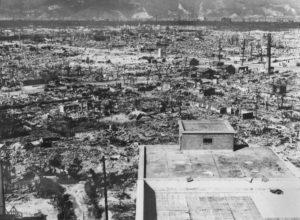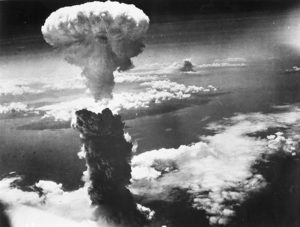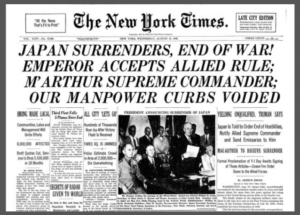The Day After—Seventy-Two Years Ago.
The Day After—Seventy-Two Years Ago.
Today is the real “Day After.” Seventy-two years ago this past week, our parents and grandparents witnessed the use of atomic bombings on Japan. August 6, 1942, United States President Harry Truman ordered the first use of an atomic bomb during wartime. The target being Hiroshima. President Truman, in a press release only 16 hours after that first bomb was dropped, released a warning to Japan to surrender or “…expect a rain of ruin from the air, the Like of which has never been seen on this earth.”
 Japan remained silent.
Japan remained silent.
Three days later, on August 9, 1945, President Truman ordered a second bomb to be dropped, this time on Nagasaki, Japan. Previously, on July 26 the Potsdam Declaration was issued. President Truman tells Japan, “surrender or suffer prompt and utter destruction.”
No one would really know the devastation caused nor the total effectiveness of the 2 atomic bombs as they were still being designed and rushed to use. Millions of casualties from all sides were estimated if a ground attack on Japan was to be ordered. Allies had been training for this attack and the soldiers from the now-surrendered European Theater were nervously awaiting the Japan attack.
What was it like for those that I interviewed? According to U.S. Marine Al Pinard, featured in “My Father’s War: Memories from Our Honored WWII Soldiers,” ‘I was on Okinawa when the atomic bomb went off. We’d never heard of an atomic bomb. I remember I was down on the air base, listening to the radio. They went to an American broadcast from the armed services to offset Tokyo Rose. They were talking about a bomb they’d dropped on Japan that had the strength of ten thousand pounds of TNT. So what? They continued to say the US had a couple more and were going to drop them if Japan didn’t surrender. Now we were excited. We were getting ready to invade Japan, and none of us really wanted to. That would have been bloody.’
 Memories from U.S. Navy Signalman Raphael Godin also featured, “They [the war ships] were all fully loaded, and the entire shoreline [of Japan] was destroyed from American and Australian gunfire.” They had no knowledge of an atomic bomb at that time. “We wouldn’t have known what the words meant.” It really didn’t mean much to Godin, because they knew only that “a new bomb was dropped on Japan and they were suffering. A few days later they [Japan] surrendered,” said Godin.
Memories from U.S. Navy Signalman Raphael Godin also featured, “They [the war ships] were all fully loaded, and the entire shoreline [of Japan] was destroyed from American and Australian gunfire.” They had no knowledge of an atomic bomb at that time. “We wouldn’t have known what the words meant.” It really didn’t mean much to Godin, because they knew only that “a new bomb was dropped on Japan and they were suffering. A few days later they [Japan] surrendered,” said Godin.
Godin’s ship went by the sites a couple of months after the atomic bomb was dropped. “Everything was just burned out. All you could see was some chimneys as we passed by.”
Then the effects from U.S. Army reconnaissance pilot Charlie Rogers. After a week’s leave, Rogers was on to another training camp in Arkansas to learn how to invade Japan. That war was still raging, with the Japanese vowing to fight till the last man’s last breath.
The new methods of launching planes (which Rogers was learning) were very scary. There was a hundred-yard cable with an arm that came down and connected to a wirelike merry-go-round. The aircraft were hooked to it by the top of the plane. As the pilot added full power (while being connected), he waved his hand when ready and they’d cut him loose to fly—one after the other. The landings were similar—by catching the top of the aircraft to the cable hook.
At the time, many other Americans felt no pity for the Japanese upon hearing that this new bomb had been dropped. “It was the right thing to do to save lives on both sides. It was the right thing to do to end the war,” Rogers said.
Fortunately for Rogers and the rest of the country, the Japanese totally surrendered on August 15, 1945, and signed the instrument of surrender on September 2, 1945.
Excerpts From: Valera, Charley. “My Father’s War:.”
This material may be protected by copyright. Available at Amazon, BN.com and other major booksellers.







